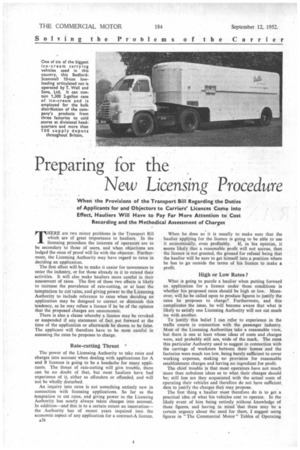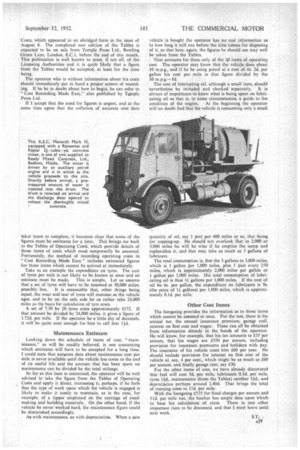Preparing for the New Licensing Procedure
Page 54

Page 55

If you've noticed an error in this article please click here to report it so we can fix it.
When the Provisions of the Transport Bill Regarding the Duties of Applicants for and Objectors to Carriers' Licences Come into Effect, Hauliers Will Have to Pay Far More Attention to Cost Recording and the Methodical Assessment of Charges
THERE are two minor problems in the Transport Bill which are of great importance to hauliers. In the licensing procedure the interests of operators are to be secondary to those of users, and when objections are lodged the onus of proof will lie with the objector. Furthermore, the Licensing Authority may have regard to rates in deciding an application.
The first effect will be to make it easier for newcomers to enter the industry, or for those already in it to extend their activities. It will also make hauliers more careful in their assessment of rates. The first of these two effects is likely to increase the prevalence of rate-cutting, or at least the temptation to cut rates, and giving power to the Licensing Authority to include reference to rates when deciding an application may be designed to correct or diminish this tendency, as he may refuse a licence if he be of the opinion that the proposed charges are uneconomic.
There is also a clause whereby a licence may be revoked or suspended if any statement of fact put forward at the time of the application or afterwards be shown to be false. The applicant will therefore have to be most careful in assessing the rates he proposes to charge.
Rate-cutting Threat
The power of the Licensing Authority to take rates and charges into account when dealing with applications for A and B licences is going to be a headache for many applicants. The threat of rate-cutting will give trouble, there can be no doubt of that, but most hauliers have had experience of it, either as offenders or offended, and will not be wholly disturbed.
An inquiry into rates is not something entirely new in connection with licensing applications. So far as the temptation to cut rates, and giving power to the Licensing Authority has nearly always taken charges into account. In addition—and this is to a certain extent an innovation— the Authority has of recent years inquired into the economic aspect of any application for a contract-A licence.
A36 When he does so it is usually to make sure that the haulier applying for the licence is going to be able to use
it economically, even profitably. If, in his opinion, it seems likely that a reasonable profit will not accrue, then the licence is not granted, the ground for refusal being that the haulier will be sure to get himself into a position where he has to go outside the terms of his licence to make a profit.
High or Low Rates ?
What is going to puzzle a haulier when putting forward an application for a licence under these conditions is whether his proposed rates should be high or low. Moreover, will he be called upon to produce figures to justify the rates he proposes to charge?. Furthermore, and this complicates the issue, he will become aware that what is likely to satisfy one Licensing Authority will not cut much ice with another.
To justify this belief I can refer to experience in the traffic courts in connection with the passenger industry. Most of the Licensing Authorities take a reasonable view, but there is one at least whose ideas of costs and charges were, and probably still are, wide of the mark. The rates this particular Authority used to suggest in connection with the carriage of workmen between their homes and the factories were much too low, being barely sufficient to cover working expenses, making no provision for reasonable establishment charges and having no ingredient for profit.
The chief trouble is that most operators have not much more than nebulous ideas as to what their charges should be; still less are they acquainted with the actual costs of operating their vehicles and therefore do not have sufficient, data to justify the charges they may propose.
The first thing a haulier must therefore do is to get a practical idea of what his vehicles cost to operate. In the likely event of him being entirely without knowledge of these figures, and having in mind that there may be a certain urgency about the need for them, I suggest using figures in "The Commercial Motor" Tables of Operating Costs, which appeared in an abridged form in the issue of August 8. The completed new edition of the Tables is expected to be on sale from Temple Press Ltd., Bowling Green Lane, London, E.C.1, before the end of this month. This publication is well known to most, if not all, of the Licensing Authorities and it is quite likely that a figure from the Tables would be accepted, at least for the time being.
The operator who is without information about his costs should immediately put in hand a proper system of recording. If he be in doubt about how to begin, he can refer to "Cost Recording Made Easy," also published by Temple Press Ltd.
If I accept that the need for figures is urgent, and at the same time agree that the collation of accurate cost data
takes years to complete, it becomes clear that some of the figures must be estimates for a time. This brings me back to the Tables of Operating Costs, which provide details of those items of costs which must temporarily be assumed. Fortunately, the method of recording operating costs in " Cost Recording Made Easy" includes estimated figures for those items which cannot be arrived at immediately.
Take as an example the expenditure on tyres. The cost of tyres per mile is not likely to be known at once and an estimate must be made. This is simple. Let us assume that a set of tyres will have to be renewed at 30,000 miles,
possibly less. It is reasonable that, other things being equal, the wear and tear of tyres will increase as the vehicle ages, and to be on the safe side let us rather take 24,000 miles as the basis for calculation of tyre costs.
A set of 7.50 by 20 tyres costs approximately £172. If that amount be divided by 24,000 miles, it gives a figure of 1.72d. per mile. If the operator be a little shy of decimals, it will be quite near enough for him to call that ifd.
Maintenance Estimate
Looking down the schedule of items of cost, " maintenance," as will be readily believed, is one concerning which estimates will have to be accepted for a long time. I could state that accurate data about maintenance cost per mile is never available until the vehicle has come to the end of its useful life and the amount that has been spent on maintenance can be divided by the total mileage.
So far as this item is concerned, the operator will be well advised to take the figure from the Tables of Operating Costs and apply it direct, increasing it, perhaps, if he feels that the type of work upon which the vehicle is engaged is likely to make it costly to maintain, as is the case, for example. of a tipper employed on the carriage of roadmaking and building materials. On the other hand, if the vehicle be never worked hard, the maintenance figure could be diminished accordingly.
As with maintenance, so with depreciation. When a new vehicle is bought the operator has no real information as to how long it will run before the time comes for disposing of it, so that here, again, the figures he should use may well be taken from the Tables.
That accounts for three only of the LB items of operating cost. The operator may know that the vehicle does about 10 m.p.g., and if he be using petrol at a cost of 4s. 2d, per gallon his cost per mile is that figure divided by the 10 m.p.g.-5d.
The cost of lubricating oil, although a small item, should nevertheless be included and checked separately. It is always of importance to know what is being spent on lubricating oil as that is, in some circumstances, a guide to the condition of the engine. At the beginning the operator will no doubt find that the vehicle is consuming only a small
quantity of oil, say 1 pint per 400 miles or so, that being for topping-up. He should not overlook that in 2,000 or 3,000 miles he will be wise if he empties the sump and replenishes it, and that may take as much as 3 gallons of lubricant.
The total consumption is, first the 3 gallons in 3,000 miles, which is 1 gallon per 1,000 miles, plus 1 pint every 250 miles, which is approximately 2,000 miles per gallon or + gallon per 1,000 miles. His total consumption of lubricating oil is thus I+ gallons per 1,000 miles. If the cost of oil be 6s. per gallon, the expenditure on lubricants is 9s. (the price of 11+ gallons) per 1,000 miles, which is approximately 0.1d. per mile.
Other Cost Items The foregoing provides the information as to those items which cannot be assessed at once. For the rest, there is the annual tax, the annual insurance premium, garage rent interest on first cost and wages. These can all be obtained from information already in the hands of the operator. He will know, for example, that his tax amounts to £35 per annum, that his wages are £350 per annum, including provision for insurance premiums and holidays with pay. The insurance of his vehicle costs him £60 per year. He should include provision for interest on first cost of the vehicle at, say, 4 per cent., which might be as much as £60 per annum, and finally garage rent, say 130. For the other items of cost, we have already discovered that fuel will cost 5d. per mile, lubricants 0.1d. per mile, tyres lid., maintenance (from the Tables) another lid., and depreciation perhaps around 2.40d. That brings the total of running costs to 11d, per mile.
With the foregoing £535 for fixed charges per annum and I ld. per mile run, the haulier has ample data upon which to base his calculation of rates. There is one other important item to be discussed, and that I must leave until next week.




















































































